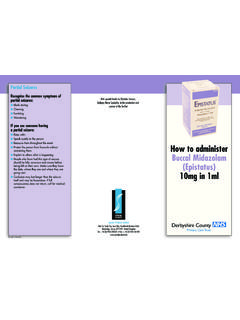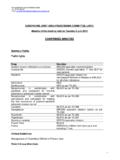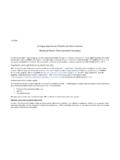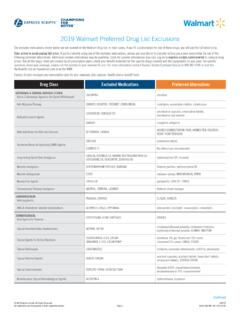Transcription of Derbyshire Medicines Management, Prescribing and ...
1 Derbyshire Medicines management , Prescribing and Guidelines Derbyshire Primary Care Formulary Chapter 13: DRUGS ACTING ON THE SKIN. Updated: November 2017. The following Prescribing guideline is relevant to the skin chapter and can be found here Actinic Keratosis Emollient Prescribing Guide Topical tacrolimus guidance Specials Specials are individually prepared formulations of existing drugs, made for a specific patient. They are usually considerably more expensive than standard preparations and are likely to incur additional Prescribing costs out of pocket expenses. Creams/ointments not listed in the BNF will usually fall under the specials umbrella. It is advisable to follow these key principles: 1.
2 Establish clinical need, is there a licensed alternative? 2. Different suppliers of the same special may have a different formulation, stability and potentially bioavailability. 3. Share the decision making process with the patient. 4. Ensure regular review for ongoing need. 5. Consider issuing acute instead of repeat prescriptions to assess patient response. 6. Expiry date of products is likely to be short. 7. BNF states that diluted creams should normally be used within 2 weeks of preparation. 8. Consider Prescribing a weaker propriety steroid rather than diluting more potent steroid. 9. Consider Prescribing a trial of urea cream rather than a special cream containing salicylic acid instead of 10% salicylic acid cream consider 10% urea cream (Aquadrate or Hydromol intensive), instead of 25% salicylic cream consider 25% urea cream (Flexitol Heel balm).
3 British Association of Dermatologist (BAD) is a charity that works closely with the Department of Health to advise the best practice and the provision of Dermatology services. It has produced a specials list to help to address concerns about high cost and lack of standards on unlicensed creams and ointments used for common dermatological conditions. management of skin conditions Suitable quantities for Prescribing for an adult Lotions Creams & Ointments Corticosteroids Twice daily application Twice daily application Once daily application for 1 week for adults for 1 week for adults for 2 weeks for adults Face 100 ml 15 to 30g 15 to 30g Both Hands 200 ml 25 to 50g 15 to 30g Scalp 200 ml 50 to 100g 15 to 30g Both arms 200 ml 100 to 200g 30 to 60g Both legs 200 ml 100 to 200g 100g Trunk 500 ml 400g 100g Groins and genitalia 100 ml 15 to 25g 15 to 30g Emollient and barrier preparations See NICE clinical guidance CG57 - management of atopic eczema in children.
4 Emollients For treatments of minor conditions such as contact dermatitis and mild dry skin/sunburn, self-care is encouraged. See Emollient Prescribing Guide Emollient choice for an individual patient involves consideration of patient preference, consistency required, patient's lifestyle and cost. There is some evidence to suggest that emollients may reduce the need to use topical steroids. Page 1 of 9. The formulary lists the most clinically and cost effective choices for Prescribing in primary care Emollient bath additives All Shower and bath emollients have been classified as BLACK by JAPC and are not recommended for Prescribing due to the lack of evidence of efficacy. Note: Drug and Therapeutics Bulletin (DTB: Vol.)
5 45 No. 10. October 2007) questioned the benefit of bath emollients. There are no published randomised controlled trials on bath emollients in atopic eczema, there is no consensus of clinical opinion that such therapy is effective. All of the emollients included in the formulary can be used as a soap substitute. The majority of bath oils and emollients can make objects very slippery, therefore caution must be taken when getting in and out of the bath, especially when caring for vulnerable groups such as older people or when handling babies. The use of aqueous cream as a leave on emollient has the potential to damage skin with increasing evidence for sodium lauryl sulphate as the causative ingredient.
6 Aqueous cream is not particularly effective as an emollient because of its low lipid Barrier preparations Barrier preparations are no substitute for adequate nursing care and should not be used in isolation. See Derbyshire Wound Care formulary Conotrane cream (dimeticone, benzalkonium chloride) 1st line in lower risk patients Drapolene cream (cetrimide, benzalkonium chloride) 1st line in lower risk patients Cutimed protect - cream, spray, foam applicator for higher risk patients- see criteria below 1. Cutimed is the cost effective alternative barrier preparation to Cavilon. These are only indicated in certain situations: Peri-wound protection film (spray, foam) indicated for protection from bodily fluids exudate Preventing incontinence dermatitis in high risk patients ( very acidic urine, diarrhoea).
7 O Not all incontinence patients will require a barrier cream; professional judgement is required. o If skin is dry/fragile an emollient cream or gel could be applied after cleansing (apply sparingly). o Barrier creams can clog incontinence pads if applied too thickly. Stomas Protecting broken or sore peristomal skin. o General barrier creams are NOT recommended as majority will reduce adhesion of bags/flanges. o Films/wipes reserved for selected patients only diabetics, palliative patients and difficult stomas o For acute prescription only 2. Zinc oxide, Sudocrem and Metanium are not recommended as they can become caked' making it difficult for healthcare workers to observe the skin properly and can also be difficult to remove.
8 3. Barrier creams should not routinely be prescribed for nappy rash in babies; suitable products are available OTC. Topical local anaesthetics and antipruritics For treatments of minor short term conditions such as insect bites and stings, patients are encouraged to self-care. Most insect bites and stings are not serious and will get better within a few hours or days. Over- the counter treatments can help ease symptoms, such as painkillers, creams for itching and antihistamines. Preparations containing crotamiton are of uncertain value therefore not routinely recommended. Topical corticosteroids Ointments are preferable to creams as they have a deeper, more prolonged emollient effect and increase the penetration of steroid.
9 They are also less likely to cause irritation as they do not contain preservatives. Where possible, patients should be maintained on emollients only. If topical steroids are required for maintenance, there should be periods each year when they are withdrawn for as long as possible and emollients used on their own. Eczema NICE TA81 recommends that topical corticosteroids are first-line treatment for flare-ups of atopic eczema and should be prescribed for application only once or twice daily. Guidelines from the British Association of Dermatologist suggest that the best way of using topical corticosteroids is probably twice daily for 10-14 days when the eczema is active, followed by a holiday period of emollients only.
10 1. UKMI. Medicines Q&A: Why is aqueous cream no longer recommended as a leave on moisturiser? January 2015. Page 2 of 9. The formulary lists the most clinically and cost effective choices for Prescribing in primary care Psoriasis See appendix 1 psoriasis pathway and NICE Clinical Guideline 153 for advice on topical corticosteroids. Mild Hydrocortisone cream 15g 1% cream/ ointment 15g, 30g, 50g cream 15g Moderate Eumovate - Clobetasone butyrate Cream/Ointment 30g Benovate RD - Betamethasone valerate Cream/Ointment 100g Alternative if Eumovate is Haelan - Fludroxycortide Cream or Ointment 60g not available Ultralanum Plain - Fluocortolone Cream or ointment 50g Potent Betnovate Betamethasone valerate Cream/Ointment 30g ; 100g.













